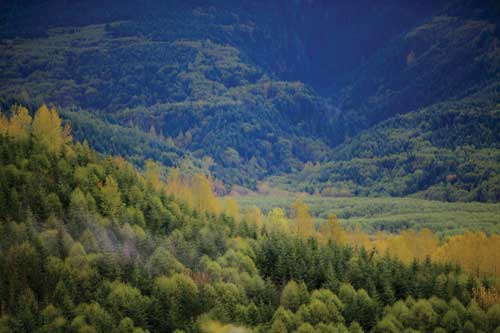Calculating Carbon Footprint
For the more detailed calculation, users enter the nominal volume of wood in a building, and the calculator then performs necessary volume conversions, makes corrections for moisture content, and arrives at a total mass figure of wood contained in the building. The tool then uses that information to estimate the building's carbon benefits.
Both the Greenhouse Gas Equivalencies Calculator and the carbon calculator were used to generate the equivalencies in this course. In the Stadthaus project shown at left, the calculators estimated significant carbon benefits from the volume of wood used.
In addition, the building was projected to weigh four times less than its concrete counterpart, which lowered transportation costs, allowed the design team to reduce the foundation by 70 percent, and eliminated the need for a tower crane during construction. Particularly impressive to the developers was the fact that the architect proposed to shave five months off the typical construction process for this type of building—a goal he managed to exceed.
Forests Absorb, Store, and Release Carbon
Responsibly managing forests in a way that balances harvesting and replanting, and provides a sustainable source of wood products that continue to store carbon and offset the use of fossil fuels, can significantly reduce the amount of carbon in the atmosphere over the long term.
As trees grow, they clean the air we breathe by absorbing carbon dioxide (CO2) from the atmosphere. They release the oxygen (O2) and incorporate the carbon (C) into their twigs, stems, roots, leaves or needles, and surrounding soil. Young, vigorously growing trees absorb the most carbon dioxide, with the rate slowing as they reach maturity (typically 60-100 years, depending on species and environmental factors). A single tree can absorb more than 10 pounds of CO2 each year.3
 |
Active forest management helps to ensure that forests store more carbon than they release. Photo by Weyerhaeuser Company |
As trees mature and then die, they start to decay and slowly release the stored carbon back into the atmosphere. Carbon is also released, but more quickly, when forests succumb to natural hazards such as wildfire, insects or disease.
Growing forests absorb, store, and release carbon over extended periods of time. Forests in the U.S. and Canada have sequestered high levels of carbon in recent decades. In both countries, net forest growth has exceeded annual forest harvests for more than 50 consecutive years.4 According to the National Report on Sustainable Forests – 2010,5 “Total U.S. forest area, as defined for the purposes of this report, currently amounts to 751 million acres, or about one-third of the nation's total land area. Since the beginning of the past century, the size of this inventory has been relatively stable, and the forests it represents remain largely intact...” In the U.S., forests and forest products store enough carbon each year to offset approximately 10 percent of the nation's total CO2 emissions.6
That said, changing environmental conditions have made the active management of forests critical. For example, wildfire is a natural and inherent part of the forest cycle. Today, however, wildfires must be prevented from burning unchecked because of danger to human life and property. As a result, many forests have become over-mature and overly dense with excess debris, which, combined with more extreme weather, has caused an increase in both the number and severity of wildfires. The combination of older forests and changing climate is also having an impact on insects and disease, causing unprecedented outbreaks such as the mountain pine beetle—which further add to the fire risk.









